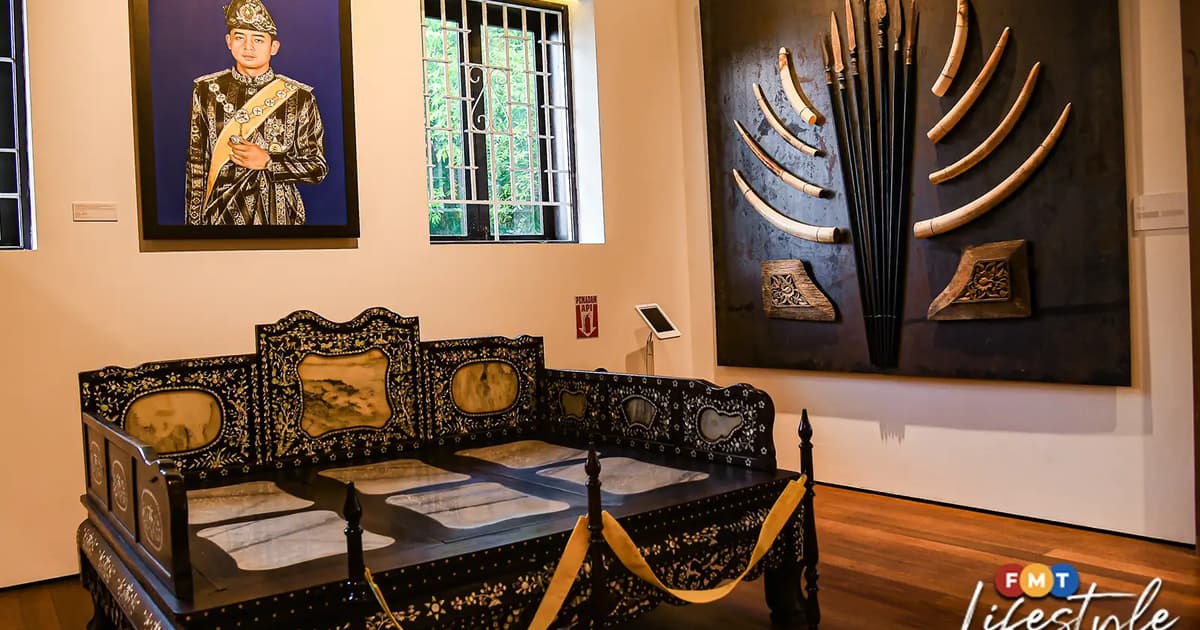
Once a royal palace, the Sultan Abu Bakar Museum in Pekan, Pahang, is now one of the state’s most cherished heritage buildings, housing a rich collection of historical artifacts, traditional crafts, and cultural treasures.
Today, this museum stands not only as a testament to the past, but also as a gateway for visitors to discover the vibrant legacy of Pahang.
As befitting a place devoted to history, the museum itself has quite an interesting background.
The building began as a simple double-storey wooden house in 1888, used as the official residence of the British Resident here.
It was later used as an administrative headquarters for the Japanese army during World War 2, before it was taken over and restored by His Royal Highness Sultan Abu Bakar, and converted into a palace named Istana Kota Beram.
The building served that function until 1976, when it was converted into a museum.

The Sultan Abu Bakar Museum occupies a large area, with exhibits spread across several halls. Expect to spend anything from half a day to a full day here.
Its spacious grounds house several military vehicles, graciously donated by the Malaysian army, as well as exquisite animal driftwood sculptures created by artist Abdul Ghafur.
In the main hall, detailed narratives on the history of Pahang trace its journey from antiquity to the modern era. On display are maps, paintings, and a wide array of artefacts, including keris, firearms, and traditional clothing.
One wall features portraits of prominent figures in Pahang’s history, including its sultans, various menteris besar and freedom fighters. Some prominent individuals to look out for include Mat Kilau and Tok Gajah.

Another highlight is a gallery dedicated to the Pahang Sultanate. It’s an excellent place to learn about royal palace customs, with artefacts such as the state’s royal regalia on display.
Fashionistas will probably enjoy the many displays of the state’s traditional clothing through the eras.
One highlight here is a modern baju kurung worn by Tengku Ampuan Pahang Tunku Azizah Aminah Maimunah Iskandariah (while serving as Her Majesty Raja Permaisuri Agong) at the coronation ceremony of King Charles III at Westminster Abbey, London.
Another highlight is a hall dedicated to the origins of life on Earth and the early development of civilisation in Malaysia. One thing which really sets this venue apart is its exploration of these themes through an Islamic perspective.
Also check out Pontian Perahu, the fragments of an ancient boat structure discovered in Hulu Sungai Pontian, Rompin, believed to be from 1657, and one of the oldest pieces of evidence for the use of technology, through a combination of tie and wooden peg use, in the Malay community.

One of the brightest spots in the museum however, has to be the Galeri Personae Inderapura, devoted to the culture and heritage of the true heart of Pahang: the rakyat.
Here, tools and artifacts showcasing different aspects of daily life, from agriculture and fishing to cooking and games take centrestage.
Visitors can admire the vibrant hues of Nyonya (Straits Chinese) porcelain, learn how to play classic pastimes such as “gasing pangkah Pahang” or “sepak raga bulat”, and appreciate the architectural ingenuity of Pahang’s ancestors through detailed scale models of heritage houses.

Of course, a trip to any museum would be incomplete without a souvenir, and the Giftshop here is well-stocked with a variety of items to remember your visit.
And if all that history makes you hungry, there are a variety of dining spots at the museum complex, including Kafe Belibis and Cuuun. Adventurous diners should head to Gerabak Kopi, where you can dine in now-unused train carriages.
Overall, this venerable venue is a great opportunity for visitors to experience the rich cultural and historical tapestry of Pahang.
With its fascinating galleries, unique artifacts, and engaging displays, the Sultan Abu Bakar Museum offers something for everyone, from history enthusiasts to curious travellers.

For more information, visit the Sultan Abu Bakar Museum website.
Sultan Abu Bakar Museum
Jalan Sultan Ahmad
Kampung Pancur
26600 Pekan
Pahang
Opening Hours:
9am- 5pm: Tuesday, Wednesday, Thursday
9am-12.15pm; 2.45pm-5pm: Friday
Closed on Monday
Ticket Prices:
- Malaysian Adults: RM12
- Students in Uniform: RM5
- Non-Malaysians: RM50
- Senior Citizens, People with Disabilities, International Council of Museums (ICOM) members: FREE






